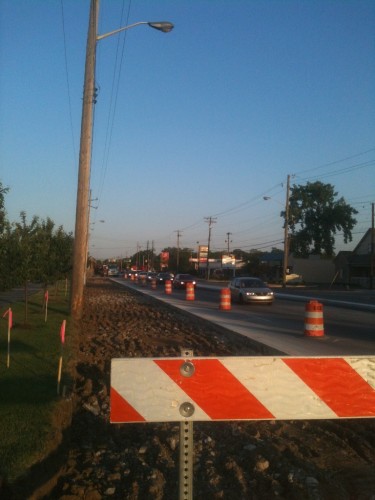I reported on the 62nd street multi-use path plans nearly a year and a half ago and I am happy to report that real earth is now being turned towards the realization of the planning. Tree removal along 62nd street has been occurring for a few weeks now. Last week, median reconfiguration began and finished. This week, pavement along the south side of 62nd street and adjacent to the Glendale Shopping Center is being removed.

With the removal of pavement, one of the most significant portions of this trail, in my opinion, is now taking place; that being the full removal of one automobile travel lane which will be replaced with the cycling trail that will travel adjacent to the shopping center.
Urban Indy will continue to provide updates as this project progresses throughout the summer construction season. On national bike to work day, it seems fitting to report on another significant Indianapolis cycling project.
I cannot tell you how awesome this is, for two big reasons:
A) A dedicated section just for bikes, two solid bike lanes!
B) It’s not straight, it winds a bit and has some organic curves to it!
That section of 62nd St. is needlessly five lanes wide. Losing the southernmost lane between Keystone and Rural doesn’t really change the traffic-handling capacity, as there are only two through lanes east of Rural (although there ought to be three for safety…two through lanes plus a CLTL…between Rural and Binford).
Does anyone know if the physical bike-car separation improvements on this Path will be more attractive than on Shelby? Thanks.
Hi it’s me again. While I am very glad to see this take shape, I think you are wrong in your description. Isn’t this a multimodal pathway? If so, why does the trail, which allows for walkers, skaters, runners, AND bikers going to continue on for that stretch between rial and keystone? I am not sure why you are calling it a “cycling trail” or later “two solid bike lanes”. You are suggesting non-bicycle traffic is not being accommodated. Is this true? If so, that’s going to be a big problem. We have lots of older folks who were looking forward to it being walker friendly.
From the DPW Website: “The 62nd Street Multi-use project will include the construction of a shared path along the south side of 62nd Street from Keystone Avenue to Allisonville Road. Planned improvements include construction of 8,125 linear feet of new trails, crosswalks, 25 ADA access ramps and new pedestrian signals. Project improvements will increase pedestrian
safety and connectivity between area businesses and neighborhoods.”
.
Full fact sheet at http://www.indy.gov/eGov/City/DPW/RebuildIndy/Projects/Documents/62StTrailFactSheet09-10.pdf
Hmmm. so I guess you got it wrong? not sure what that last post is all about.
I don’t want to sound like a jerk here, but this basically seems like a wide sidewalk, something most cities install as a given in residential areas. The fact that Indianapolis is just getting around to this AND needs 1.4 million dollars in FEDERAL FUNDING to pay for theirs is not something to brag about. People here complain about government spending all the time, but get very quiet when the pork comes home. Same thing for the Georgia Street “upgrade”—that was entirely federally funded as well.
For what it’s worth, I think the majority of people here that complain about government spending aren’t complaining so much that money is being spent by the government, but that it’s being spent poorly.
Dutch – Speak for yourself… I’m not against government spending at all, but I don’t want to get off topic here….Sidewalks in this country are not very common. I know California recently passed complete streets act to address this problem. Maybe that’s something to look into.
Multi-use paths are just that…accommodating of pedestrians, runners, strollers, bicycles, rollerblades, etc. Of necessity, they are wider that sidewalks designed for pedestrians only. They provide a safe separation of human-powered transportation from motor vehicles.
A whole lot of transportation infrastructure is paid for with federal funds. Projects that get 80% federal, 20% local funds are very common. It’s not pork, it’s a mechanism for distributing funds. And I don’t think you could find very many people who would argue that transportation infrastructure categorically is not a legitimate government expense.